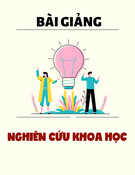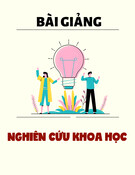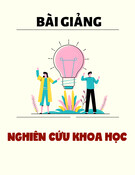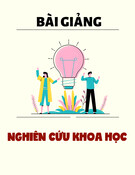
Pak. j. life soc. Sci. (2025), 23(1): 3664-3681 E-ISSN: 2221-7630;P-ISSN: 1727-4915
Pakistan Journal of Life and Social Sciences
www.pjlss.edu.pk
https://doi.org/10.57239/PJLSS-2025-23.1.00290
3664
RESEARCH ARTICLE
Factors Influencing the Scientific Competency of High School
Students: A Case Study in Northern Vietnam
Tran Thi Thu Hue1, Nguyen Quang Linh2*, Do Huong Tra3, Ngo Trong Tue4
1 Cao Bang Specialized High School
2 Thai Nguyen University of Education
3,4 Hanoi University of Education 2
ARTICLE INFO
ABSTRACT
Received: Nov 17, 2024
Accepted: Jan 22, 2025
Keywords
Scientific Competency
High School Students
Exploratory Factor Analysis
(EFA)
Educational Factors
Vietnam Education
*Corresponding Author:
linhnq@tnue.edu.vn
This study explores the factors influencing the scientific competency of high
school students in Northern Vietnam. Using a quantitative approach, the
research collected survey data from 380 students, employing exploratory
factor analysis (EFA) and multivariate regression to identify and evaluate
key factors. Five groups of factors were found to significantly affect scientific
competency: individual factors, family factors, school factors, social factors,
and personal motivation. Among these, school-related factors, including
teaching quality and the learning environment, along with individual factors
such as students’ personal motivation and self-study skills, were identified
as having the strongest impact on scientific competency. The regression
analysis further confirmed that school factors exert the highest influence,
with a standardized coefficient (β) of 0.708. Conversely, factors such as
social influences showed lower statistical significance. This study provides
empirical evidence to guide educational policy and instructional
improvements in the Vietnamese context, suggesting that enhancements in
teaching quality and student motivation can lead to better scientific
outcomes. Additionally, the research underscores the need for targeted
educational interventions aimed at improving scientific competency, with a
focus on addressing the specific challenges faced by students in Northern
Vietnam.
1. INTRODUCTION
1.1. Scientific competency and the interest in students' scientific competency in education in
Vietnam
The concept of scientific competency is used to describe abilities related to activities such as
questioning phenomena, scientifically interpreting data and evidence, and using scientific
information for decision-making and action (Bybee et al., 2009; Muelle, 2020; White et al., 2023).
Scientific competency plays an important role because it allows individuals to gain a broader vision
of the world, to reconcile their knowledge with real-world situations through critical, creative, and
innovative thinking, which is highly effective for professionals. It promotes the application of basic
competencies to understand reality and fosters the learning of science by taking into account the
surrounding environment and the transition from theory to practice (Guzmán, Oliveros & Mendoza,
2017).
In the context of current global development, scientific competency in students plays a crucial role in
equipping the younger generation with the necessary knowledge and skills to confront modern
societal challenges. Particularly, as Vietnam strives to become a developed nation, the education

Hue et al. Factors Influencing the Scientific Competency of High School Students
3665
system has shifted from content-based teaching to competency-based education, including scientific
competency development (Ministry of Education and Training, 2018).
Focusing on scientific competency not only helps students gain a deeper understanding of natural
and social phenomena but also contributes to the development of critical thinking, problem-solving
skills, and decision-making based on data and evidence. In Vietnam, although the 2018 National
General Education Curriculum has introduced reforms aimed at developing students' scientific
competency, many challenges remain. Therefore, researching and identifying factors that affect
students' scientific competency is essential, not only for improving teaching quality but also for
creating educational strategies tailored to specific regions and groups of students.
1.2. The research area
Vietnam is geographically divided into three regions: North, Central, and South. Each region has its
own distinct economic, cultural, and social characteristics, yet all share the common cultural identity
of the Vietnamese people. In Northern Vietnam, there are areas with strong economic, cultural, and
social development, particularly in cities like Hanoi and Hai Phong, which offer favorable conditions
for students to develop scientific competency (General Statistics Office of Vietnam, 2023, p. 118).
However, the North also includes mountainous, remote, and rural areas where economic and
educational opportunities are more limited. This diversity makes it essential to study the scientific
competency of students in the North to understand the unique challenges and strengths of this
region, enabling the development of targeted policies and interventions that ensure equitable access
to quality science education for all students.
Northern Vietnam is geographically divided into three sub-regions: the Northeast, Northwest, and
Red River Delta, comprising 25 provinces. The population of Northern Vietnam is primarily rural,
with an average population density of about 450 people per square kilometer. This region has a total
of 993 secondary schools with 28,175 classes and 1,164,010 students, including 601,649 female
students and 211,577 ethnic minority students. On average, each class has about 40.5 students, and
the student-teacher ratio is 20.3 (General Statistics Office of Vietnam, 2023, p. 899).
In the 2022-2023 academic year, Northern Vietnam faced a shortage of about 58,000 teachers out of
the total 445,000 teachers currently available (Tuoi Tre Newspaper, 2023). The Red River Delta
region had the lowest teacher-to-class ratio at the secondary school level (Public Policy Development,
2023). In terms of infrastructure, the Northern mountainous region had the lowest rate of permanent
school facilities in the country (Ministry of Education and Training, 2023). At the lower secondary
level, the rate of permanent classrooms exceeded 92.44%, and at the upper secondary level, the
Northern mountainous provinces had a rate of over 95% for permanent classrooms. However, the
availability of essential teaching equipment was still low; in the Northern midland and mountainous
region, the lower secondary level met about 97% of the teaching equipment needs, while the upper
secondary level met only about 51.6% (Mai et al., 2023; Ministry of Education and Training, 2023).
1.3. Research objectives and questions
The overall objective of this study is to explore and identify the factors affecting the scientific
competency of high school students in Northern Vietnam. To achieve this goal, the study focuses on
determining the factors that have the greatest impact on students' scientific competency and
evaluating the extent of their influence. Based on these findings, the research will provide specific
recommendations aimed at improving and enhancing students' scientific competency in the local
educational context, thereby contributing to the overall development of science education quality in
the region.
To address these objectives, the study will answer the following research questions:
1. What factors influence the scientific competency of high school students in Northern Vietnam?
2. To what extent do these factors impact the students' scientific competency?
These questions aim to clearly identify the influencing factors, thereby laying the foundation for
proposing solutions to improve the teaching and learning of science subjects for high school students
in the local area.
Để đưa ra câu hỏi này cần tổng quan những NC điều tra về NLKH hơn là những nhận định ở trên vì
nó ít ăn nhập với câu hỏi đưa ra.

Hue et al. Factors Influencing the Scientific Competency of High School Students
3666
1.4. Significance of the research
Theoretically, this research deepens understanding of the factors influencing students' scientific
competency in a specific context, expanding existing science education theories. It clarifies how
cultural, social, and educational conditions impact students' competency within the Vietnamese
education system, laying a foundation for future research in similar contexts. Practically, the study
provides valuable data for educational managers, teachers, and policymakers to improve science
education quality. The findings will help schools design more effective curricula, fostering
comprehensive development of students' scientific skills and supporting efforts to enhance
educational outcomes and human resource development in modern society.
2. LITERATURE REVIEW
2.1. Theoretical fframework
2.1.1. Scientific competency
Scientific competency encompasses a broad range of skills and abilities that allow individuals to
apply scientific knowledge to identify problems, construct new knowledge, provide explanations, and
draw conclusions based on evidence. It also includes the development of reflective thinking, enabling
individuals to actively participate in resolving issues related to science (Mayasari & Usmeldi, 2023).
These competencies are essential for students as they foster critical thinking, creativity, and
innovation, which are crucial for their personal and professional development (Conel, 2021,
Mardiana & Cahyani, 2018). The Programme for International Student Assessment (PISA) provides
a robust framework for understanding scientific competency. According to PISA (2006), scientific
competency is defined as the ability to use scientific knowledge to identify, explain, and draw
conclusions about scientific phenomena and issues. This definition emphasizes understanding
science as an inquiry-based process and the role science plays in shaping the natural world (Bybee
et al., 2009). In the PISA (2018) framework, scientific competency is broken down into three key
components:
1. Explaining phenomena scientifically: This involves recognizing, offering, and evaluating
explanations for a range of natural and technological phenomena.
2. Evaluating and designing scientific inquiry: This refers to describing and appraising
scientific investigations and proposing ways of addressing scientific questions.
3. Interpreting data and evidence scientifically: This competency includes analyzing and
evaluating data, claims, and arguments presented in various forms and drawing scientifically
appropriate conclusions (Muelle, 2020).
The upcoming PISA (2025) extends these competencies to include the ability to engage in reasoned
discourse on topics related to science, sustainability, and technology. A scientifically educated
individual should be able to explain phenomena, construct and evaluate designs for scientific inquiry,
and critically interpret scientific data and evidence. This also includes obtaining and evaluating the
credibility of scientific information related to specific global, local, or personal issues and using this
information to make informed decisions (Muelle, 2020; White et al., 2023).
Scientific competency also involves a range of specific skills. These include the ability to recall and
apply scientific knowledge, identify and evaluate models, and recognize and formulate explanatory
hypotheses related to the material world. Students must also be able to identify research questions,
propose appropriate experimental designs, and evaluate whether the designs are suitable for
answering specific scientific questions. Additionally, the competency involves searching for,
evaluating, and communicating the merits of different sources of information relevant to making
decisions on scientific issues (Bybee et al., 2009; White et al., 2023).
Attitude plays a significant role in the development of scientific competency. Engaging with science-
related issues and considering them critically, using both scientific knowledge and values, is a key
aspect of scientific competency. The extent to which students engage in extracurricular and out-of-
school science activities also contributes to their development of scientific competency. Students’
enjoyment of learning about science, both in and out of school, is a strong indicator of their overall
engagement and success in developing these competencies (White et al., 2023).

Hue et al. Factors Influencing the Scientific Competency of High School Students
3667
2.1.2. Factors affecting scientific competency
Understanding the factors that influence scientific competency is critical for educators and
policymakers in fostering better learning environments. These factors, which span individual,
familial, school, and societal domains, interact to shape students' ability to acquire and apply
scientific knowledge effectively. Below, we explore each factor in detail.
Individual factors
Several individual traits play a vital role in shaping scientific competency. Learning motivation is one
of the primary drivers, as students with high intrinsic motivation tend to perform better
academically. Studies show a positive correlation between intrinsic motivation, curiosity, and
students’ academic performance in science (De-Silva et al, 2018; Jayawardena et al., 2020).
Additionally, students' attitudes toward science—such as their willingness to engage with scientific
issues and critically assess scientific information—also contribute significantly to their competency
(White et al., 2023). Lastly, self-learning skills such as reading habits and creativity have been found
to strongly influence scientific literacy. Students who engage in independent learning activities
develop greater scientific competency compared to those who rely solely on teacher-directed
learning (Mayasari & Usmeldi, 2023).
Family factors
The role of the family in developing scientific competency cannot be understated. Parental support,
both financial and emotional, has been shown to positively impact students' achievement in science.
Parents who provide additional tuition, motivate their children to study, and emphasize the
applications of science in daily life contribute to higher academic performance (De-Silva et al., 2018).
Moreover, parents' educational background is another influential factor. Children of parents with
higher educational attainment often receive more help with homework and are exposed to a broader
range of learning experiences (Jayawardena et al., 2020). Lastly, the family’s socio-economic status
significantly impacts students' performance. Students from higher socio-economic backgrounds tend
to perform better in science due to greater access to resources and a more supportive home
environment (Dudaite, 2016).
School factors
School-related factors, including teaching methods, facilities, and teacher qualifications, are critical
to the development of scientific competency. Inquiry-based learning strategies have been
particularly effective in promoting scientific reasoning and critical thinking skills (Krell et al., 2020).
Schools that provide well-equipped laboratories and access to technology create environments that
support the development of students’ scientific skills (De-Silva et al., 2018). Moreover, the quality of
teachers—especially their understanding of scientific literacy and the ability to teach inquiry-based
methods—has been identified as a major determinant of students' scientific competency (Prinsloo &
Harvey, 2018).
Social factors
Social influences, including peer groups and the broader community, also shape scientific
competency. Peer learning environments, where students can discuss and explain scientific concepts
to one another, foster deeper understanding and retention of scientific knowledge (Altun, 2015).
Additionally, the community environment, particularly whether students live in urban or rural areas,
impacts their access to scientific resources and opportunities. Students in urban settings generally
have greater access to educational resources, leading to better academic outcomes in science
(Dudaite, 2016).
In conclusion, scientific competency is shaped by a complex interplay of individual, familial, school,
and social factors. Among these, school-related factors, such as teaching quality and resources, and
individual factors, including motivation and self-learning skills, appear to exert the greatest
influence. Recognizing and addressing these factors in educational policies and practices is essential
for fostering the development of scientific literacy in students, ensuring they are well-equipped for
future scientific challenges.

Hue et al. Factors Influencing the Scientific Competency of High School Students
3668
2.2. Research model
The research model in this study aims to examine the factors influencing the scientific competency
of high school students. The dependent variable is defined as the students' scientific competency,
measured through their average academic performance in science subjects, including Mathematics,
Physics, Chemistry, Biology, Technology, and Technology. Given the structure of Vietnam’s education
system, where students are required to study Mathematics but have the option to select other science
subjects based on their study combination, the research uses the average scores from four selected
science subjects per the students' chosen study combination.
Figure 1: Research model
The independent variables in this study include individual, family, school, and social factors, all
hypothesized to directly impact students' scientific competency. Individual factors cover learning
motivation, attitudes, perceptions, and self-learning skills, which drive students' engagement and
independent study. Family factors, such as parental involvement, educational background, and socio-
economic status, are crucial to academic success. School factors involve the quality of teaching
methods, teacher qualifications, and access to resources like laboratories, all essential for fostering
scientific skills. Social factors include peer influence, community educational policies, and societal
attitudes toward science, which shape students' competency.
The proposed research model illustrates the relationships between these independent variables and
the dependent variable, scientific competency. To test these hypotheses, the study employs
Exploratory Factor Analysis (EFA) to identify the underlying structure of the influencing factors and
Regression Analysis to measure the impact of the independent variables on students' scientific
competency. This model not only identifies the most significant factors but also provides a foundation
for practical recommendations aimed at improving science education within the local context.
3. METHODOLOGY
3.1. Research design
This study adopts a quantitative research design aimed at measuring the factors that influence
scientific competency among high school students in Northern Vietnam. A survey method was chosen
to collect data due to its efficiency in gathering large amounts of information across multiple
respondents in a relatively short time, and its ability to generalize the findings across the population.
The research process consists of three main stages.
First, developing measurement instruments. A survey questionnaire was created based on the
theoretical framework and prior studies to ensure that all questions align with the research
objectives and accurately measure the identified variables. This questionnaire was piloted with a
small sample to test its reliability and validity. Afterward, adjustments were made to ensure that the
instrument could effectively capture the variables under study.
Second, sampling and data collection. A stratified random sampling method was used to ensure high
representativeness and reduce sampling error. The sample included students from various types of
high schools and different geographical areas across Northern Vietnam. This approach ensures that
the findings can be generalized across the region. Data were collected through online surveys, a
method chosen for its accessibility and ease of use, particularly after the Covid-19 pandemic, where
students became more accustomed to digital platforms.

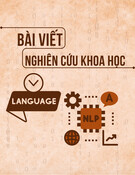
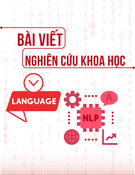


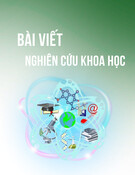

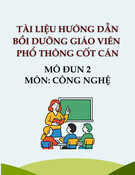


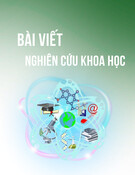



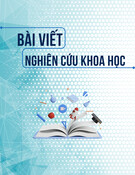

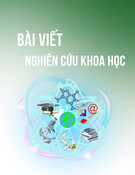

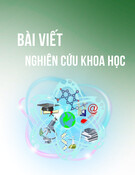

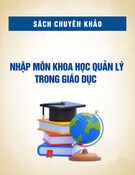
![Định hướng giáo dục STEM trong trường trung học: Tài liệu [chuẩn/mới nhất]](https://cdn.tailieu.vn/images/document/thumbnail/2025/20251124/dbui65015@gmail.com/135x160/25561764038505.jpg)
